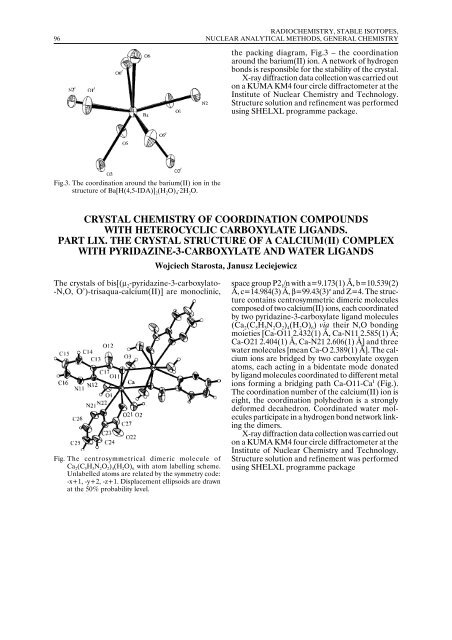annual report annual report annual report annual report 2005
annual report annual report annual report annual report 2005
annual report annual report annual report annual report 2005
You also want an ePaper? Increase the reach of your titles
YUMPU automatically turns print PDFs into web optimized ePapers that Google loves.
96<br />
RADIOCHEMISTRY, STABLE ISOTOPES,<br />
NUCLEAR ANALYTICAL METHODS, GENERAL CHEMISTRY<br />
the packing diagram, Fig.3 – the coordination<br />
around the barium(II) ion. A network of hydrogen<br />
bonds is responsible for the stability of the crystal.<br />
X-ray diffraction data collection was carried out<br />
on a KUMA KM4 four circle diffractometer at the<br />
Institute of Nuclear Chemistry and Technology.<br />
Structure solution and refinement was performed<br />
using SHELXL programme package.<br />
Fig.3. The coordination around the barium(II) ion in the<br />
structure of Ba[H(4,5-IDA)] 2<br />
(H 2<br />
O) 4·2H 2<br />
O.<br />
CRYSTAL CHEMISTRY OF COORDINATION COMPOUNDS<br />
WITH HETEROCYCLIC CARBOXYLATE LIGANDS.<br />
PART LIX. THE CRYSTAL STRUCTURE OF A CALCIUM(II) COMPLEX<br />
WITH PYRIDAZINE-3-CARBOXYLATE AND WATER LIGANDS<br />
Wojciech Starosta, Janusz Leciejewicz<br />
The crystals of bis[(µ 2 -pyridazine-3-carboxylato-<br />
-N,O, O’)-trisaqua-calcium(II)] are monoclinic,<br />
Fig. The centrosymmetrical dimeric molecule of<br />
Ca 2 (C 5 H 3 N 2 O 2 ) 4 (H 2 O) 6 with atom labelling scheme.<br />
Unlabelled atoms are related by the symmetry code:<br />
-x+1, -y+2, -z+1. Displacement ellipsoids are drawn<br />
at the 50% probability level.<br />
space group P2 1 /n with a=9.173(1) Å, b=10.539(2)<br />
Å, c=14.984(3) Å, β=99.43(3) o and Z=4. The structure<br />
contains centrosymmetric dimeric molecules<br />
composed of two calcium(II) ions, each coordinated<br />
by two pyridazine-3-carboxylate ligand molecules<br />
(Ca 2<br />
(C 5<br />
H 3<br />
N 2<br />
O 2<br />
) 4<br />
(H 2<br />
O) 6<br />
) via their N,O bonding<br />
moieties [Ca-O11 2.432(1) Å, Ca-N11 2.585(1) Å;<br />
Ca-O21 2.404(1) Å, Ca-N21 2.606(1) Å] and three<br />
water molecules [mean Ca-O 2.389(1) Å]. The calcium<br />
ions are bridged by two carboxylate oxygen<br />
atoms, each acting in a bidentate mode donated<br />
by ligand molecules coordinated to different metal<br />
ions forming a bridging path Ca-O11-Ca I (Fig.).<br />
The coordination number of the calcium(II) ion is<br />
eight, the coordination polyhedron is a strongly<br />
deformed decahedron. Coordinated water molecules<br />
participate in a hydrogen bond network linking<br />
the dimers.<br />
X-ray diffraction data collection was carried out<br />
on a KUMA KM4 four circle diffractometer at the<br />
Institute of Nuclear Chemistry and Technology.<br />
Structure solution and refinement was performed<br />
using SHELXL programme package
















